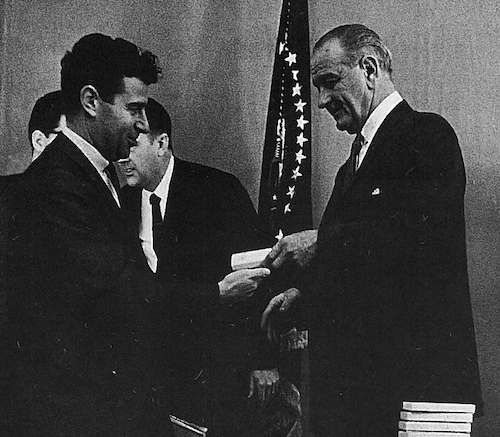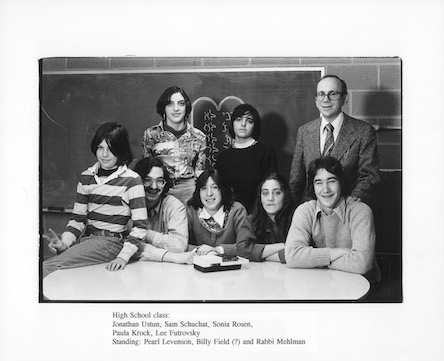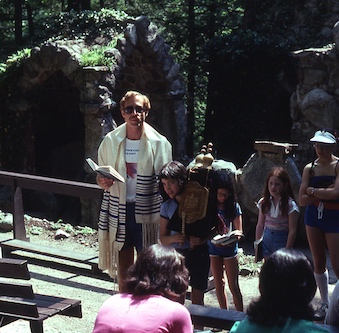What would become Temple Micah held its first High Holy Day services in 1963 at the Bethel Pentecostal Church in Southwest Washington. Rabbi Martin Cohen, a professor at the Hebrew Union College-Jewish Institute of Religion, the Reform rabbinical seminary in New York, conducted the worship, using a conservative prayer book. According to the incipient congregation’s newsletter, 111 adults purchased tickets for $12.50 each. Children less than 13 years old could attend without charge.
And so began the congregation’s tradition of worshipping in its own way, what later became known as The Micah Way.

At first lay members led the Friday night services, but in 1964, they hired Rabbi Richard G. Hirsch (z”l), creator and director of Reform’s Religious Action Center in DC to conduct one Shabbat service a month. The early membership comprised substantial numbers of both Reform and Conservative Jews, so initially worshippers juggled both Conservative and Reform prayer books at each Friday night service. Then, the congregation compiled its own prayer book.
In 1966, having outgrown the Pentecostal church, the Southwest Hebrew Congregation (SWHC)—as the temple was known then—moved its worship to St. Augustine’s Episcopal Church at 6th and M Streets, SW., where it would remain (under an unprecedented sharing arrangement signed in 1971) until 1995.

SWHC, soon to become Temple Micah, hired its first full time rabbi—Bernard H. Mehlman—in 1967, one year after affiliating with the Reform movement. Before he took the job, Mehlman insisted that the congregation use the Reform prayer book. Over his 11-year tenure, he created an original Micah way of worship. Among other things, he set rigorous standards for Bar/Bat Mitzvah and ruled out the common Reform practice of confirmation. With small groups of congregants, he rewrote parts of the High Holy Day services. He started holding Selichot services the Saturday night before Rosh Hashanah. And, with the donation of six mini Kiddush cups, he invited children attending the service to partake, beginning the ongoing tradition of handing out small kiddush cups of grape juice to first time worshippers.
Mort Goren Interview
Mort Goren, who joined the congregation in 1966, talks about Rabbi Mehlman, explains why we usually don’t have rabbis conduct our summer services, and how he started Saturday morning services in the summers.

Rabbi Robert K.Baruch (z”l) succeeded Rabbi Mehlman in 1978. During his 5-year tenure, he enhanced the music in the worship services including the liturgical music commissioned by a member of the temple. He also instituted the practice of preparing for the High Holy Days with special prayers during the Hebrew month of Elul.
In 1983, Rabbi Daniel G. Zemel arrived at Temple Micah and has continued to make innovations in worship in his three-decade-plus tenure.
Rabbi Zemel On The Worship Service When He Came to Micah and How He Began to Change It
The service tended toward what we could call a Temple Micah version of classical Reform Judaism…We didn’t know what we wanted to do with prayer but we knew we had to change something.
Rabbi Zemel
Rabbi Zemel On the Evolution of the Worship Services and Hiring Music Director and Cantorial Soloist
Rabbi Zemel On Crafting the Worship Service
Rabbi Zemel Describes our Worship Service as a Sacred Drama
Liz Lerman refers to her dance and movement sessions at Temple Micah as “moving Jewish communities.”
The physical brings them closer to the person they’re sitting next or to the text or to their memories or even whatever they may think about faith and God.
Liz Lerman
Rabbi Zemel and the Challenge of Making Services Relevant and Spiritually Moving
Rabbi Zemel Talks About Sermons
Kol Isha Seders
Open to all, Kol Isha is a community of study and practice which explores Judaism’s rich traditions and texts through the lens of women’s energies, interpretations, and images of the divine. For the last several years, they have hosted a community Seder.